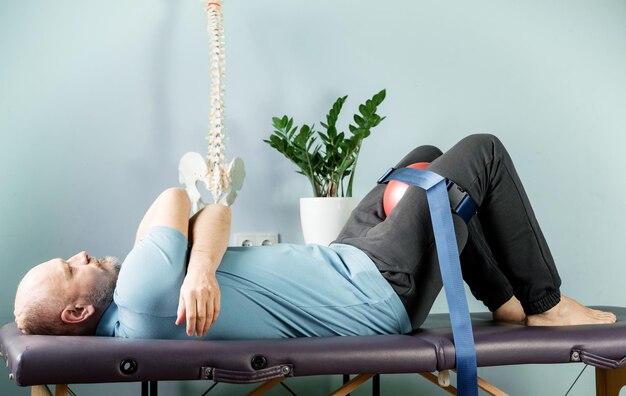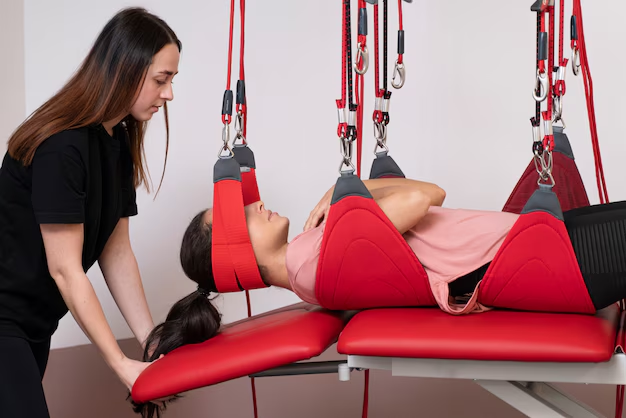Visit Our Location
64 Park Rd N, Oshawa, ON L1J 4L1, Canada
Traction therapy is a form of physical therapy used to alleviate pain, relieve pressure, and improve mobility by gently stretching the spine and joints. This technique can be highly effective for treating various musculoskeletal conditions, particularly those affecting the spine, back, and neck. By applying controlled force, traction therapy works to create space between vertebrae and joints, which can reduce pressure on nerves, relieve muscle tension, and promote healing. For those seeking relief in the local area, Traction Pain Therapy in Oshawa offers specialized treatments designed to address these concerns and improve overall well-being.

Traction therapy involves the use of a mechanical or manual device that applies a pulling or stretching force to specific parts of the body, such as the spine, neck, or limbs. The goal of traction is to stretch the soft tissues and joints, reduce pain, and enhance mobility.
Traction therapy can be used in conjunction with other physical therapy techniques to promote healing, increase flexibility, and relieve discomfort.
Traction therapy is commonly used to treat a wide range of musculoskeletal conditions, including:
One of the most common uses of traction therapy is for relieving back pain, especially pain caused by spinal issues. By gently stretching the spine, traction can help decompress the vertebrae and reduce pressure on the spinal discs, muscles, and nerves.
Traction therapy is also effective for relieving neck pain. It can help alleviate discomfort caused by pinched nerves, muscle tension, or herniated discs in the cervical spine. By applying a controlled pulling force, the therapy can create more space between the vertebrae, relieving pressure and reducing pain.
Herniated discs occur when the soft, gel-like substance inside a spinal disc pushes through the outer layer, causing pain and discomfort. Traction therapy can help alleviate the pressure on the disc and surrounding tissues, promoting healing and reducing symptoms.
Sciatica is a condition that occurs when the sciatic nerve is compressed, leading to pain and numbness along the lower back, hips, and legs. Traction therapy can relieve pressure on the nerve and reduce pain associated with sciatica.
When nerves are compressed or pinched by surrounding tissues, it can lead to pain, tingling, or weakness. Traction can help reduce the pressure on these nerves and improve nerve function, leading to pain relief.
Spinal stenosis is a condition where the spinal canal narrows, putting pressure on the spinal cord and nerves. Traction therapy can help alleviate this pressure by creating space in the spinal column, leading to reduced pain and improved mobility.
Facet joints are small joints in the spine that can become inflamed or irritated due to wear and tear. Traction therapy can help reduce the pressure on these joints and improve spinal movement, which can ease pain and discomfort.
Degenerative disc disease is a condition where the spinal discs break down over time, leading to pain, stiffness, and reduced mobility. Traction therapy can help relieve pressure on the affected discs and reduce symptoms associated with the condition.
Traction therapy can be used to correct or alleviate misalignments in the spine, which may be contributing to pain and discomfort. By stretching and realigning the vertebrae, traction helps to restore proper spinal posture and function.
Traction therapy works by applying a controlled, gentle pulling force to the affected areas of the body. When the force is applied, it creates a space between the vertebrae, joints, or muscles, reducing the pressure on nerves and soft tissues. This process helps to relieve pain, decrease muscle tension, and improve flexibility and movement. For those seeking relief in the region, traction pain therapy in Oshawa offers a local solution tailored to alleviate discomfort and enhance mobility with the same principles of controlled traction therapy.

The therapy is typically performed in a series of sessions, each lasting from 10 to 30 minutes, depending on the condition being treated. During a traction session, the patient will lie on a treatment table, and the therapist will adjust the traction machine or manually apply force to specific areas of the body. The amount of force and the duration of treatment can be customized to meet the patient’s individual needs and comfort level. For those seeking effective treatment, Traction Pain Therapy in Oshawa offers tailored solutions to address various musculoskeletal issues and relieve discomfort.
If you are dealing with any of these conditions, traction therapy may help alleviate your symptoms and improve your overall quality of life.
If you are experiencing pain or discomfort due to spinal or joint issues, consider exploring the benefits of traction therapy. It is a non-invasive, effective treatment option for a variety of musculoskeletal conditions. Contact us today to learn more about how traction therapy can support your recovery and improve your mobility.